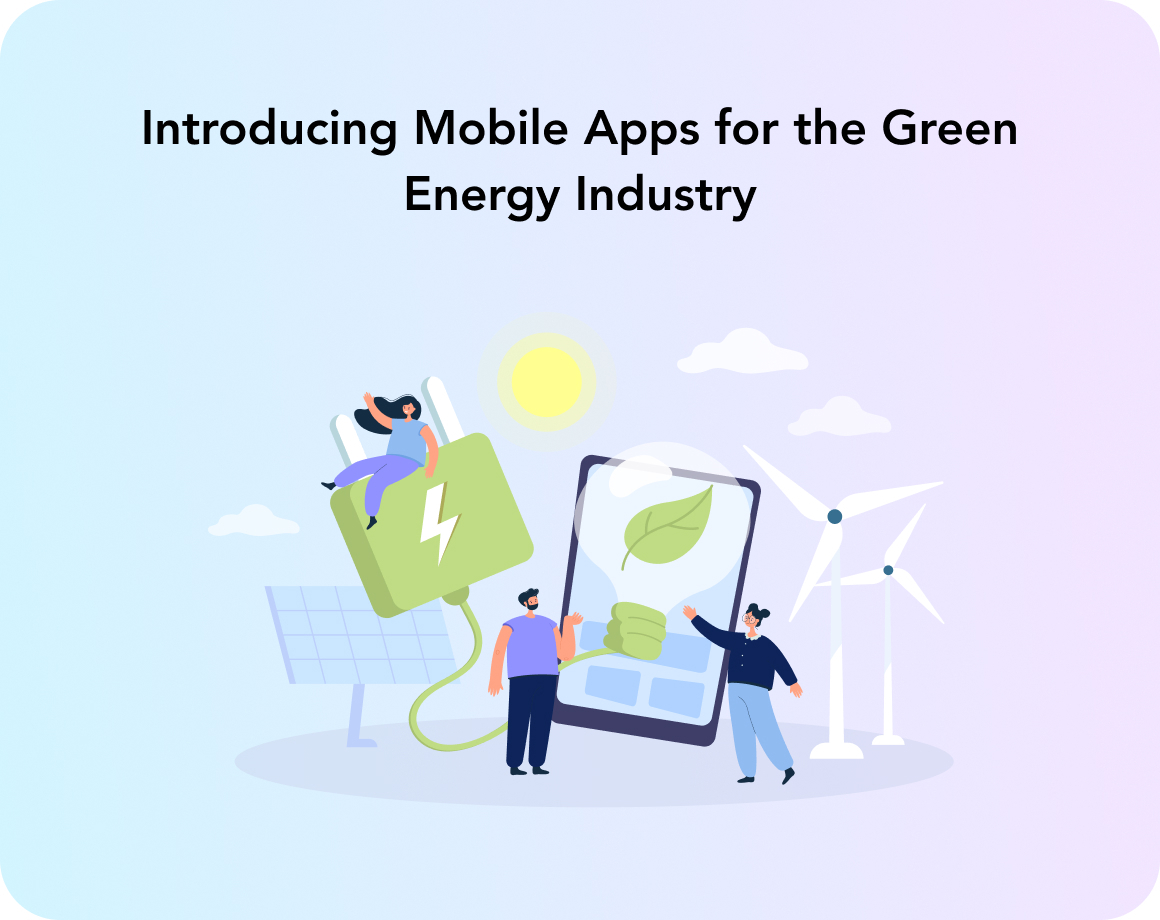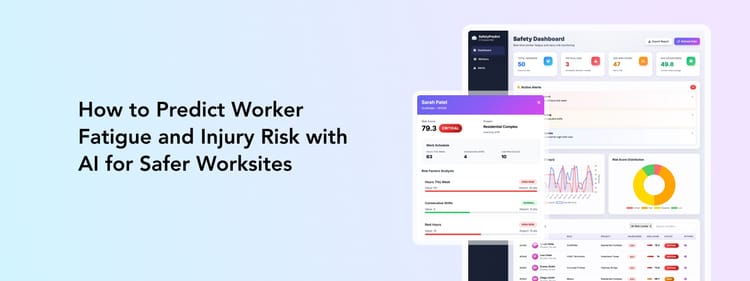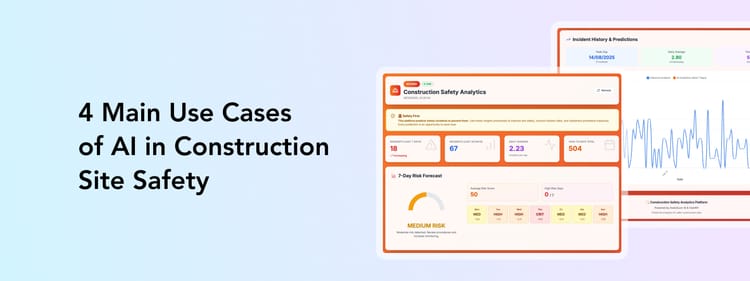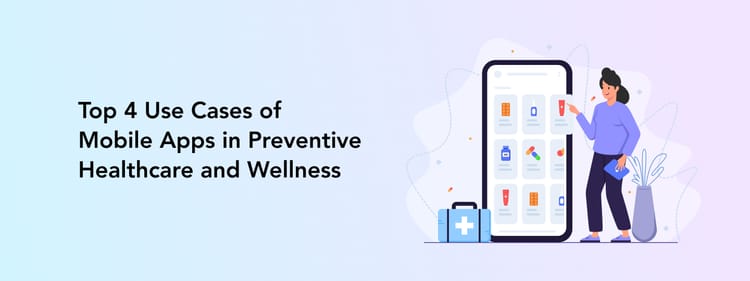What's powering the green energy industry today? Not just solar panels and wind turbines — but data. And the easiest way to access that data? A mobile app.
As green energy systems become more complex, the ability to monitor and control them in real time is no longer optional — it’s essential. Global renewable electricity generation is projected to climb to over 17,000 terawatt-hours (TWh) by 2030, nearly double the output of 2023 — enough to meet the combined power demand of China and the United States. With this rapid growth comes a pressing need to track production, consumption, and system efficiency across a wide range of energy setups.
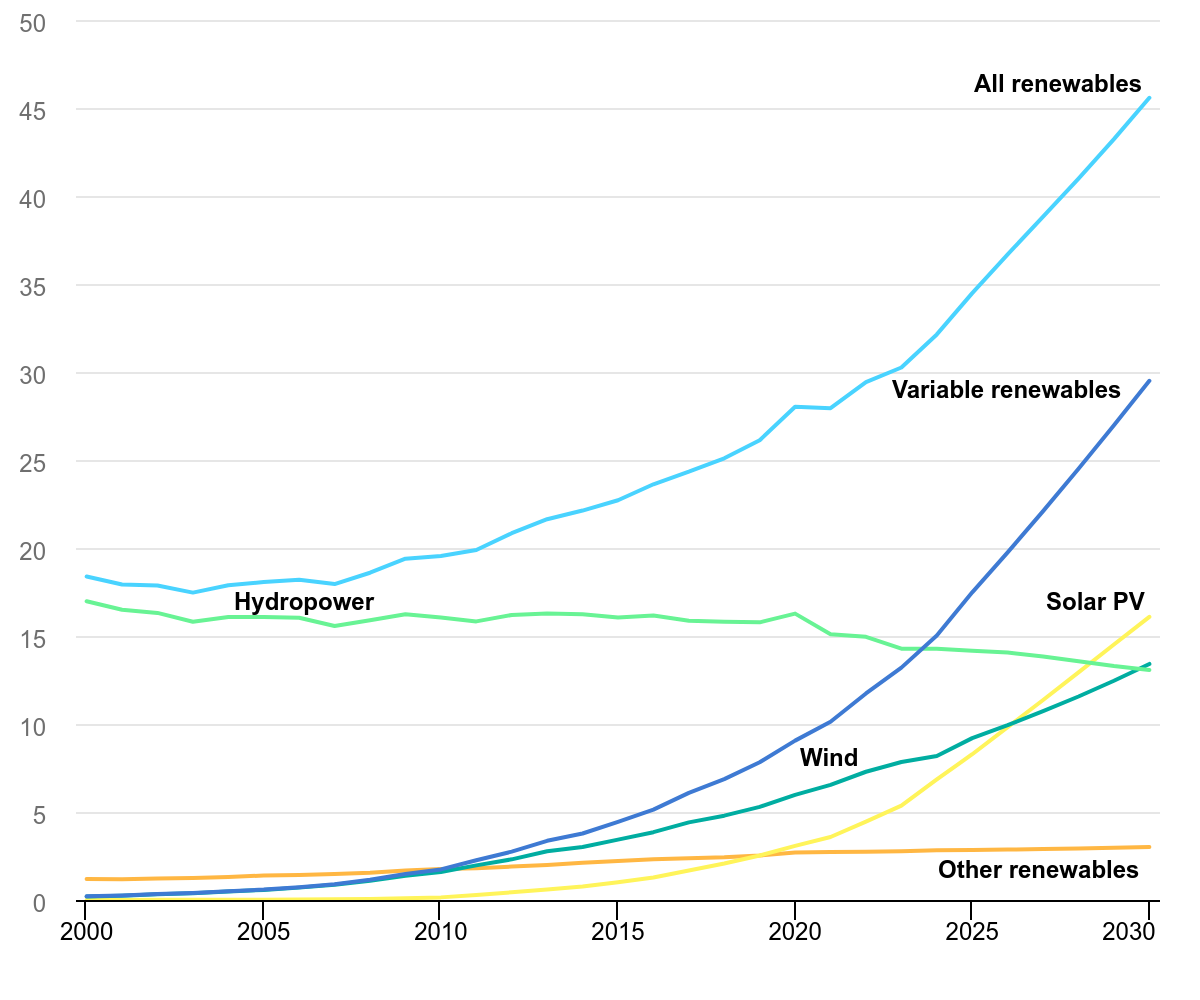
Over the next five years, major milestones will further reshape the energy landscape. Wind and solar will each surpass nuclear by 2026. And by 2029, solar PV is set to become the world’s largest renewable power source, overtaking hydropower with wind expected to follow in 2030.
IoT sensors in smart meters, HVAC systems, and energy grids generate valuable insights every second. But without an intuitive app, that data often stays locked away.
That’s where mobile solutions come in. From real-time monitoring to usage analytics and predictive maintenance, apps connect users with the systems behind renewable energy making it easier to track, optimize, and act.
In this article, we’ll explore how mobile apps are assisting the green energy sector and how your tech team can build one that truly makes an impact.
Top Mobile App Use Cases for the Green Energy Industry
Let’s discover the most common use cases of mobile app connectivity for the green energy.
Energy consumption tracking
Smart meters are revolutionizing the way we manage utility consumption. These IoT devices automatically record energy, water, and gas usage in real time, replacing manual readings with continuous, detailed data.
However, the real value comes when that data is presented in a user-friendly mobile app. For instance, a mobile app can visualize energy consumption in daily, weekly, or monthly formats using color-coded graphs and personalized alerts. Users can track specific appliances, compare usage between time periods, and even receive tips on how to reduce their energy footprint.
Perpetio recently developed a smart meter mobile app that transformed abstract kWh data into visual insights. Each device’s consumption is presented both in raw numbers and percentages, so users can easily spot which rooms or appliances are driving up their utility bills. The app's interface includes energy-saving recommendations based on usage patterns, offering a practical way to support eco-conscious lifestyles.
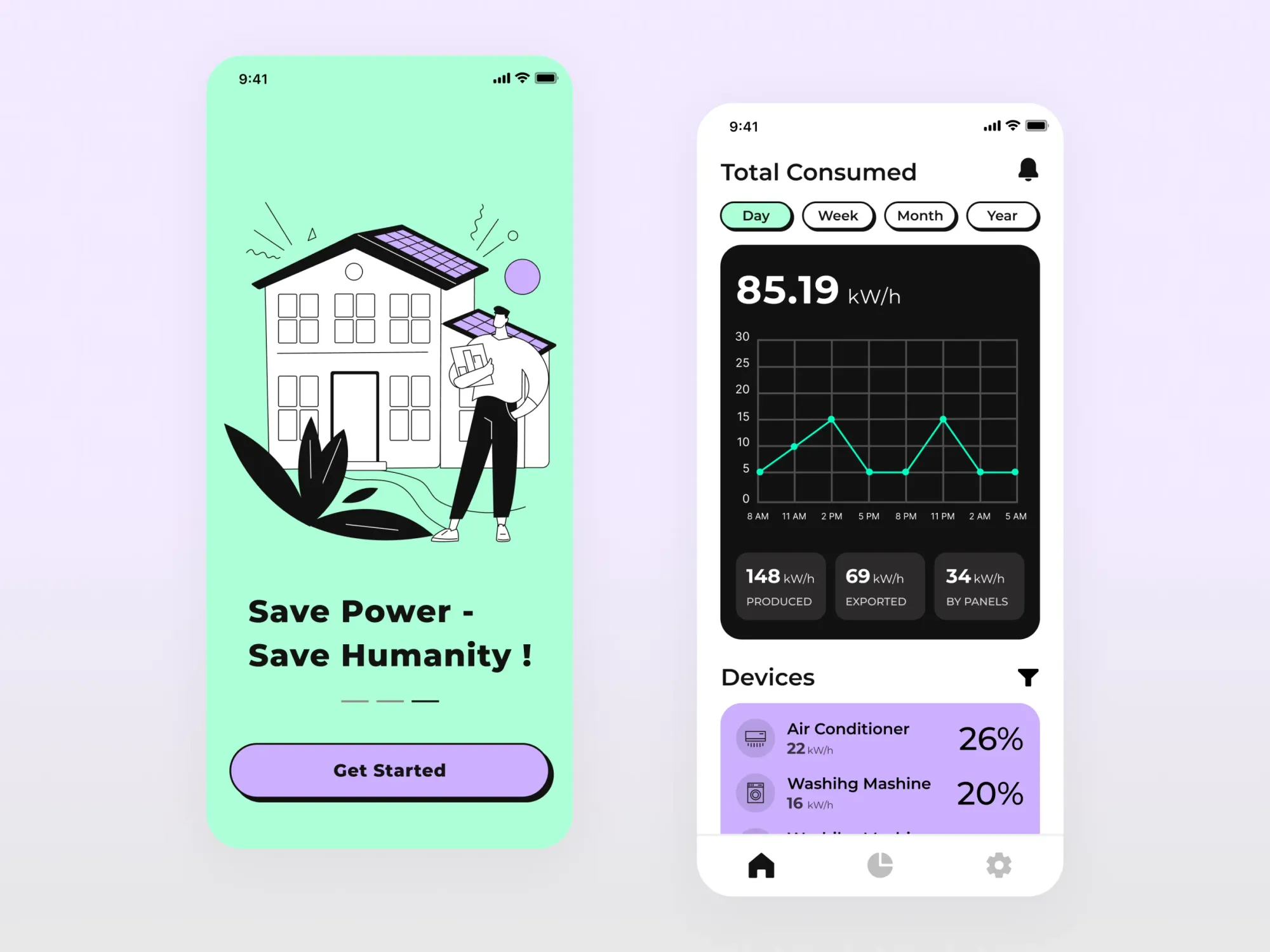
Smart HVAC systems can go even further. These systems track indoor air conditions, like temperature, humidity, and lighting, and allow users to adjust them remotely. In one of our smart home projects, we created a mobile app where users could control devices by room, view each system’s stats, and set up schedules to save energy. For example, the app can automatically lower the heating when no one is home or turn off ventilation in unused rooms. These small adjustments, powered by mobile access, contribute to both comfort and cost savings.

Performance monitoring
In 2024, solar and wind power dominated global renewable energy expansion, accounting for 96.6% of all net capacity additions. Solar made up over three-quarters of this growth, rising by 32.2% and reaching 1,865 GW. Wind energy followed with an 11.1% increase.
With such numbers, the need for continuous and accessible monitoring to remain stable and productive increases. Facility owners, employees, or residents can check the devices’ performance through an app.
Mobile apps offer a window into these systems, pulling live data from smart grids, solar panels, turbines, and storage units. Grid operators can use this information to track voltage fluctuations, adjust energy output, or identify any component that’s underperforming — all from a mobile device. This is especially helpful in distributed systems where visiting each installation manually would be time-consuming and inefficient.
For example, solar panels in different geographic locations might experience different weather conditions, which affects their output. A mobile app allows operators to compare performance across sites and make real-time adjustments. If a set of panels is producing less than expected due to debris or shading, the app can flag the issue so that maintenance can be scheduled right away. Similarly, if battery storage is nearing capacity or running low, operators can shift energy flow with just a few taps.
Smart grid integration is key here. You can develop dashboards where grid operators can view energy flow in real time and even simulate how changes in demand or weather will impact supply. That means fewer surprises, better planning, and more stable green energy delivery.
Predictive maintenance
Traditional maintenance often happens too late — when a system has already failed or is showing serious signs of wear. Mobile apps with predictive maintenance capabilities flip the script. By collecting and analyzing data from vibration, temperature, and pressure sensors, these apps can detect small anomalies that hint at future problems. This early warning system allows companies to fix issues before they cause downtime or damage.
Take the example of a wind farm. Each turbine is fitted with sensors that detect its rotation speed, vibration intensity, and internal temperature. For example, a monitoring app might notice that one turbine is shaking more than usual. This can alert the team to check it early and find a small problem, like a worn-out part. Fixing it in time can stop bigger damage. Later, the app sees the same pattern in another turbine — and again, it turns out to be the same issue.
Beyond one-time alerts, these apps also build up historical data that helps improve predictions over time. The more the app learns about the normal behavior of each asset, the better it can spot what’s out of place. This reduces emergency maintenance, lowers repair costs, and extends the lifespan of equipment — a major benefit in capital-heavy sectors like green energy.
Remote access to field data
One of the biggest challenges in the green energy industry is geographic spread. Solar farms, wind turbines, and other infrastructure are often located in remote or rural areas, making real-time updates hard to access without physical presence. Mobile apps solve this by giving managers, technicians, and even investors direct access to real-time field data from anywhere in the world.
For instance, a field engineer might be in transit when they receive a mobile notification that a turbine is operating outside normal parameters. They can immediately check performance charts, compare data to historical trends, and inform the nearest technician, all without visiting the site.
In another case, a C-level executive may want to review energy output trends from all sites before a board meeting. With a mobile dashboard, they can get detailed summaries and export reports with a few taps.
How to Connect a Mobile App to IoT Devices and Smart Meters
Smart meters and IoT sensors make this possible by tracking everything from electricity usage to equipment health. However, without a mobile app to access this data remotely, these devices lose much of their value. Mobile apps act as a bridge between the user and IoT hardware, enabling remote control, data insights, and automation — all from a smartphone.
Connecting smart meters and sensors to a mobile app requires more than just syncing data. Developers must ensure the app can communicate with different hardware types, process incoming data reliably, and deliver that information to users in a simple, actionable format.
For example, a solar energy app might connect to inverters, battery sensors, and weather stations — all speaking different "languages." The mobile app must unify them into a single dashboard, using APIs and standard communication protocols.
Creating such an IoT app involves building a multi-layered architecture, which is more intricate than a typical mobile application. Unlike traditional apps, IoT apps interact with various devices and sensors, requiring seamless data exchange and robust backend support. Here's a quick look at how that structure is built:
- Layer 1: Devices and sensors
The foundation of the system — smart meters, environmental sensors, and energy trackers collect real-time data from the physical world. - Layer 2: Network connectivity
Networks like Wi-Fi, LoRaWAN, or NB-IoT transmit data from devices to the cloud, using protocols such as MQTT for efficient communication. - Layer 3: Middleware and cloud
Processes raw data, applies rules or logic, and stores it in the cloud. APIs connect this layer to the mobile app for real-time access. - Layer 4: Mobile application
The user interface that displays insights, allows remote control, and visualizes trends using charts, notifications, and device controls.
Consider Perpetio Your Trusted Partner
Perpetio has supported businesses in creating smart, user-friendly IoT mobile solutions, from residential parking apps to energy meter systems for homes. These tools help users gain clarity, convenience, and better control in their daily routines.

If your team is planning a new green energy solution, we’re ready to help. Get in touch to discuss your project — we’d love to bring your idea to life.
